Personal lives
Phillip Burgoyne Hudson was the son of Charles Hudson, Railway Commissioner of Victoria. As a child he attended Wellington College in New Zealand and moved to The Friends College High School to continue his education in his early teens. In 1903 Hudson moved to Melbourne and attended Melbourne University to pursue a career in Architecture. [2]
In 1904 Hudson was articled to Anketell Henderson in 1904 and began a practice with D’Ebro over the period of 1904-09. [3] Soon after he established a practice of his own in 1909. Hudson also began teaching architectural drafting with Harold Desbrowe-Annear and Haddon at the Working Mens College, now known as RMIT University.
A year later, he met Ethel Elise Vincent and was married on 14 December 1910. Ethel gave birth to one son and two daughters and lived in their home in Garden Vale which was designed by Hudson himself in 1914. [7]
Born in 1891, James Hastie Wardrop was enlisted in A.I.F. in October 1915, and served in Europe before traveling to England to study briefly in 1919. [7]

The Mausoleum at Halicarnassus or Tomb of Mausolus was a tomb built between 353 and 350 BC in Halicarnassus for Mausolus, a native Anatolian from Caria and a satrap in the Achaemenid Empire, and his sister-wife Artemisia II of Caria. The structure was designed by the Greek architects Satyros and Pythius of Priene. Its elevated tomb structure is derived from the tombs of neighbouring Lycia, a territory Mausolus had invaded and annexed circa 360 BC, such as the Nereid Monument.

Toorak is an inner suburb of Melbourne, Victoria, Australia, five kilometres (3.1 mi) south-east of Melbourne's Central Business District, located within the City of Stonnington local government area. Toorak recorded a population of 12,909 at the 2016 Census.

St Kilda Road is a street in Melbourne, Victoria, Australia. It is part of the locality of Melbourne which has the postcode of 3004, and along with Swanston Street forms a major spine of the city.
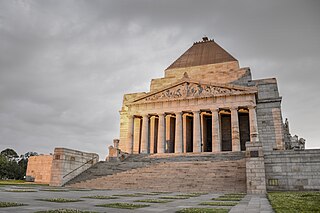
The Shrine of Remembrance is a war memorial in Melbourne, Victoria, Australia, located in Kings Domain on St Kilda Road. It was built to honour the men and women of Victoria who served in World War I, but now functions as a memorial to all Australians who have served in any war. It is a site of annual observances for ANZAC Day and Remembrance Day, and is one of the largest war memorials in Australia.
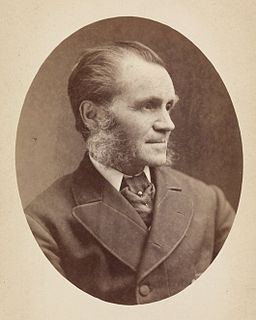
Joseph Reed, a Cornishman by birth, was one of the most talented, prolific and influential Victorian era architect in Melbourne, Australia. He established his practice in 1853, which through various partnerships and name changes, continues today as Bates Smart, one of the oldest firms continually operating in Australia.
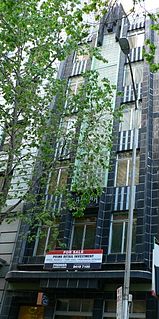
Alkira House is a historic building in Melbourne, Australia. It is widely regarded as one of Melbourne’s most stunning examples of Art Deco architecture. Built in 1936 by architect, James Wardrop, Alkira House is located at 18 Queen Street.

Tourism in Melbourne is a significant industry in the state of Victoria, Australia. The country's second most-populous city, Melbourne was visited by 2.7 million international overnight visitors and 9.3 million domestic overnight visitors during the year ending December 2017.
Sir Roy Burman Grounds was one of Australia's leading architects of the modern movement.
Australian non-residential architectural styles are a set of Australian architectural styles that apply to buildings used for purposes other than residence and have been around only since the first colonial government buildings of early European settlement of Australia in 1788.

Paul Raphael Montford was an English-born sculptor, also active in Australia; winner of the gold medal of the Royal Society of British Sculptors in 1934.
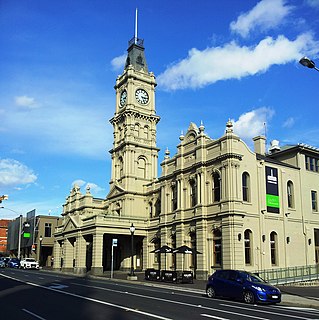
John Beswicke (1847–1925) was an architect who practiced in Melbourne between the 1870s and 1915.
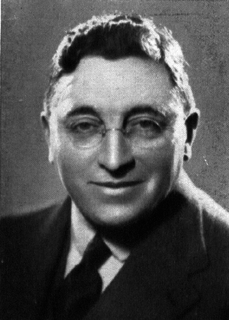
Joseph Plottel was a British born architect who was active in Melbourne, Australia between 1911 and World War II, working in a range of revival styles, as well as Art Deco in the 1930s. He is best known for the St Kilda Synagogue (1927) and the Footscray Town Hall (1936).
Geoffrey Harley Mewton (1905–1998) was an Australian architect and leading proponent of modern architecture in Melbourne during the 1930s. He is best known for the Woy Woy flats at Elwood, Victoria, amongst the first flat blocks in Melbourne to show the influence of the European Modern movement.

Perrott Lyon Mathieson was an Australian architecture firm based in Melbourne, Australia. Founded by Leslie M Perrott in 1914, the firm was responsible for numerous high-profile projects from the 1920s to the 1990s, and was associated with the Perrott and Lyon architectural families, spanning three generations and 8 practitioners.
Graeme Butler is a heritage architect who has practiced in Melbourne, Australia for near to 40 years. He is principal of the heritage firm Graeme Butler & Associates, and author of many urban conservation and heritage studies and the authority on the Californian bungalow in Australia, which has been described as ...the quintessential work on the form.
William Arthur Purnell F.R.A.I.A., generally known as Arthur Purnell, and sometimes A W Purnell, was an Australian born architect who practiced in Canton, China in the 1900s, and from 1910 mainly in Melbourne, Australia. He is most noted for the few designs in Melbourne that include Chinese references.
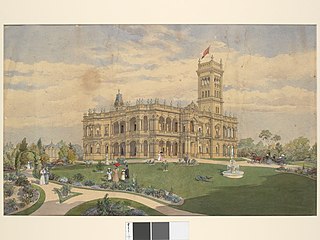
William Henry Ellerker was an architect and politician in Melbourne, Victoria, Australia. He was Mayor of St Kilda.
Sydney Wigham Smith was an architect in Melbourne, Australia, principal of the firm of Sydney Smith, Ogg and Serpell.











